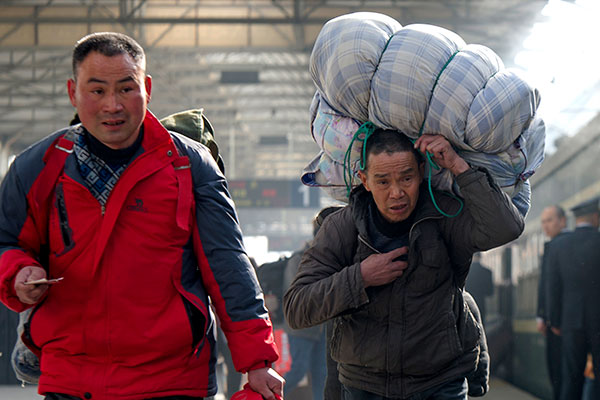
Migrant workers leave Urumqi Railway Station in the Xinjiang Uygur autonomous region. China’s migrant population reached 253 million by the end of last year.[Chen Feng / For China Daily]
China’s migrant population is becoming older on average and will continue to grow in the next few years, according to a report released by China’s top health authority.
As of the end of last year, the number of migrants reached 253 million, an increase of 32 million over 2010, according to the report released on Nov 11 by the National Health and Family Planning Commission.
The number of migrants will continue to rise by about 6 million annually over the next few years, and the total number is expected to reach 291 million by the end of 2020, according to the commission.
The report shows that the migrant population has been growing over the past several years and more migrating families are taking their elders with them.
In other words, the elders become migrants as they accompany their working children. The elders are often not workers.
Migrants over 45 years old accounted for 12.9 percent of the total last year, compared with 9.7 percent in 2010, the report said.
In addition, more than half of those in the migrant population are willing to settle down in the cities where they work. On average, migrant workers have stayed in the place where they are living now for more than three years, the report said.
Yuan Xin, a professor of population studies at Nankai University in Tianjin, said the rising number of elders in the total migrant population shows that the group has been living a steadier life and are better integrated into society.
“Only when the pioneering migrants, normally males, are living a steadier life can they bring other members of their families to unite with them, such as their wives and children, and finally their parents,” he said.
“This shows the living and working environment for migrant workers has been improving in the past several years.”
The rise in migrants above 45 years old is putting greater pressure on the public services and social welfare systems of big cities, according to Wang Qian, chief of migrant population management at the National Health and Family Planning Commission.
“We have been paying attention to the fact that China has entered into a stage where elders have started migrating,” he said. “We have conducted surveys on the conditions of those elders, especially their health status and access to health services, for future policymaking.”
The health authorities will make more efforts to help migrants to have equal access to healthcare services with permanent residents, and ensure uninterrupted services in different places, he said.
Yuan said that although migrant workers, mostly from rural areas, still do not enjoy the same social welfare benefits as urban residents, the gap has been narrowing in recent years.
“People’s minds are changing. Society takes more measures to acknowledge the contributions of migrant workers in urban development,” he said. “But I think it will take time for migrant workers to enjoy the same status as urban residents.”
The current household registration system in China needs to be reformed so that migrant workers from rural areas can enjoy the same status and social welfare benefits as urban residents, he said.
China will unify its urban and rural household registration systems to help migrant workers gain access to benefits by 2020, according to a guideline issued last year by the State Council.
